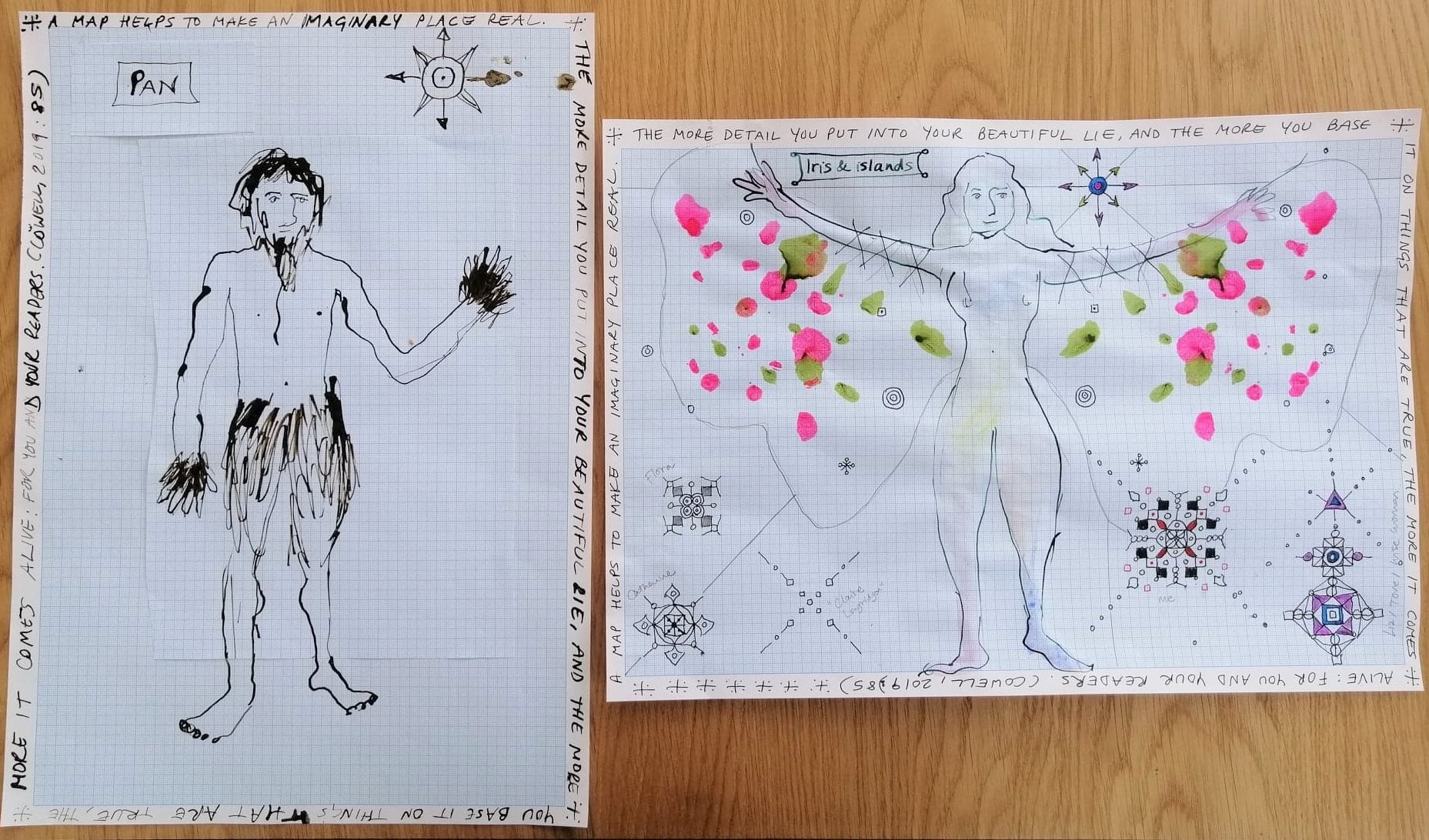Dreamscapes, wildscapes
Rachel Godfrey, Dream maps 6a and 6b: Pan and Iris (2020)
Pan and Iris
Pan is a wild island, of solid high cliffs and waterfalls.
His latitudes and longitudes are currently unknown.
I would sail from his right foot, around the cape of his heel and up the coastline of the leg, and traverse overland to his left shoulder and left hand.
Iris, the butterfly woman,
Lies deep under the sea, submerged. Her form is seen from the air and known to sailors.
Five islands are emerging, SW and SE.
Some are just breaking the surface, forming sandbanks and skerries.
Others are rising up high, and are as compasses
That show true north.
Pink and green coral forms show beneath the surface
– dancer, warrior, teacher, peace-maker, sage.
~ ~ ~
dream (n) = a series of images, events and feelings that happen in your mind while you are asleep (OUP, 2022)
map (n) = a symbolic representation of selected characteristics of a place, usually drawn on a flat surface (National Geographic, 2022)
~ ~ ~
I have a love-hate relationship with my dreams. They’re absurd, capricious, tantalisingly slippery to grasp upon waking, and often present me with unpalatable images. Too much engagement with them makes me feel a bit giddy. Then, I’d rather feel the solidity of a chalk path on the South Downs beneath my feet, the wetness and chill on my body of a rough Cornish sea, its foam lit up as bright as snow by sunshine, or the wind on my face as I circle an iron-age hillfort in Dorset. But I find I keep getting drawn back to those night-time showings, and can’t ignore the idea that my dreaming self has things to say that help me in my waking hours (Estés, 1992: 458-9). I’m not so much interested in my dreaming self’s rambling narratives, as in the isolated images she offers me – the people, places, animals and objects.
In early 2020, as part of my MSc in Creative Writing for Therapeutic Purposes, I undertook a research project to explore what happened when I mapped my dreams in words and images. Much has been written about using dreams as the starting point for reflective creative writing (Metzger, 1992; Bolton, 1999; Hunt, 2006; Alexander, 2014; Bolton 2014), and the work fell into a long tradition of ‘dream elaboration’ (Ihanus in Bolton, Field, & Thompson, 2010: 36), a re-telling of my dreams by my waking mind. My approach to dream elaboration was different to that of others, though, in that I devised a unique approach to dream journalling which enabled me to survey and map my dream landscapes. As a result of my explorations, I gained new personal insights and felt better integrated - both within myself and in connection to the physical landscape and natural world around me. Five key themes emerged: Orientation, Perspective, Journeys, Beasts and Body.
‘Pan and Iris’ is piece of free-writing from week six of my research project, a prose poem in response to the pair of dream maps which I’d created that week by combining colours and images from a series of dreams. In the reflective writing, I imagined engaging with the land forms represented there as real places - body as land and land as body. Male Pan was rugged and daunting but accessible to me the adventurer; female Iris, and the other forms around her, was more appealing, but out of my reach.
Two years on from the project, I remain fascinated by how while our bodies rest in sleep, our dreaming minds process vast quantities of information, make creative associations, solve problems, generate new knowledge and nurse our mental and emotional health (Walker, 2018: 216-32). I continue to balance creative dream exploration with grounding self-care practices such as yoga, running and gardening, and am excited to be offering an eight-week Dreaming Self workshop to guide others in the approach I’ve found to be so helpful and enlightening as part of an ongoing journey of self-discovery.
~ ~ ~
Alexander, J. (2014) Writing in the House of Dreams. Charleston: Five Lanes Press
Bolton, G. (1999) The Therapeutic Potential of Creative Writing. London: Jessica Kingsley Publishers
Bolton, G. (2014) ‘Chapter 11: Dreams’, in The Writer’s Key. London: Jessica Kingsley Publishers
Estés, C. P. (1992) Women Who Run with the Wolves London: Rider
Hunt, C. (2000) Therapeutic Dimensions of Creative Writing. London: Jessica Kingsley Publishers
Metzger, D (1992) Writing for your Life. San Francisco: HarperSanFrancisco
National Geographic (2022) ‘Map.’ Resource Library Encyclopaedic Entry. Available at: <https://www.nationalgeographic.org/encyclopedia/map/> (accessed 24.08.2020)
Oxford Learner’s Dictionary (2022) ‘Dream.’ Available at: <https://www.oxfordlearnersdictionaries.com/definition/english/dream_1?q=dream> (Accessed 18.02.2022)
Walker, M (2017) Why We Sleep. London: Penguin Random House

